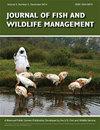Availability of Supplemental Corn for Sandhill Cranes, Light Geese, and Dabbling Ducks Wintering in New Mexico
IF 0.9
4区 环境科学与生态学
Q4 BIODIVERSITY CONSERVATION
引用次数: 0
Abstract
The Middle Rio Grande Valley of central New Mexico overwinters the majority of the Rocky Mountain Population of greater sandhill cranes Antigone canadensis tabida as well as numerous Mid-continent Population lesser sandhill cranes A. c. canadensis, light geese (i.e., snow Anser caerulescens and Ross’s geese Anser rossii), and dabbling ducks (i.e, Anas spp.). Stemming from changes in agricultural practices and loss of habitat, these species have become largely dependent on public lands where corn is used to supplement natural foraging resources providing a key dietary component while also discouraging crop depredation on private lands. To evaluate if supplemental corn provides a sufficient resource base, we estimated energy available in corn resources and seasonal energy requirements of the sandhill cranes, which was comprised of Rocky Mountain Population and Mid-continent Population. Additionally, we considered energetic requirements for two other wintering guilds, light geese and dabbling ducks. Depletion rates of post-mowed corn increased throughout winter from 3,673 ± 843 kg/ha/day (mean ± SE) in December to 7,014 ± 1,884 kg/ha/day in February. Estimated seasonal energetic requirements of the Rocky Mountain Population and Mid-continent Population were 1.14 × 109 kcal (95% CI = 1.07 × 109 – 1.21 × 109 kcal). Combined, seasonal energetic demands of the Rocky Mountain Population, Mid-continent Population, light geese, and dabbling ducks was 4.23 × 109 kcal (95% CI = 3.81 × 109 – 4.53 × 109 kcal) or 911,813 kg of corn (95% CI = 820,821-1,006,894 kg). From 2014-2017, corn production on public lands in the Middle Rio Grande Valley was 1,052,006 ± 58,965 kg grown on an average of 76 ha, sufficient for winter energetic requirements of all guilds. Interagency collaboration, effective planning during the growing season and strategic schedules for mowing supplemental corn crops that integrate population abundances and their respective energy demands should further promote success of the supplemental corn program in the Middle Rio Grande Valley.在新墨西哥州越冬的沙丘鹤、轻雁和涉水鸭补充玉米的有效性
新墨西哥州中部的中部格兰德山谷过冬的大部分是落基山脉的大沙丘鹤Antigone canadensis tabida,以及许多中部大陆的小沙丘鹤a.c. canadensis,轻雁(即雪雁caerulescens和罗斯鹅Anser rossii)和涉水鸭(即Anas spp.)。由于农业实践的变化和栖息地的丧失,这些物种在很大程度上依赖于公共土地,在公共土地上,玉米被用来补充自然觅食资源,提供了关键的饮食成分,同时也阻止了私人土地上的作物掠夺。为了评估补充玉米是否提供了足够的资源基础,我们估算了玉米资源的可用能量和由落基山种群和中大陆种群组成的沙丘鹤的季节性能量需求。此外,我们还考虑了另外两个越冬行会的能量需求,轻型鹅和涉水鸭。刈割后玉米耗损率从12月的3673±843 kg/ha/day(平均±SE)增加到2月的7014±1884 kg/ha/day。落基山种群和中大陆种群的季节能量需要量为1.14 × 109 kcal (95% CI = 1.07 × 109 ~ 1.21 × 109 kcal)。综合计算,落基山种群、中大陆种群、轻鹅和涉水鸭的季节性能量需求为4.23 × 109 kcal (95% CI = 3.81 × 109 ~ 4.53 × 109 kcal)或911,813 kg玉米(95% CI = 820,821 ~ 1,006,894 kg)。2014-2017年,中部大河谷公共土地玉米产量为1052,2006±58,965公斤,平均种植面积76公顷,足以满足所有行会的冬季能量需求。跨部门合作、生长季节的有效规划以及综合人口丰度和各自能源需求的补种玉米割草战略时间表,将进一步促进中里约热内卢格兰德河谷补种玉米计划的成功。
本文章由计算机程序翻译,如有差异,请以英文原文为准。
求助全文
约1分钟内获得全文
求助全文
来源期刊

Journal of Fish and Wildlife Management
BIODIVERSITY CONSERVATION-ECOLOGY
CiteScore
1.60
自引率
0.00%
发文量
43
审稿时长
>12 weeks
期刊介绍:
Journal of Fish and Wildlife Management encourages submission of original, high quality, English-language scientific papers on the practical application and integration of science to conservation and management of native North American fish, wildlife, plants and their habitats in the following categories: Articles, Notes, Surveys and Issues and Perspectives. Papers that do not relate directly to native North American fish, wildlife plants or their habitats may be considered if they highlight species that are closely related to, or conservation issues that are germane to, those in North America.
 求助内容:
求助内容: 应助结果提醒方式:
应助结果提醒方式:


